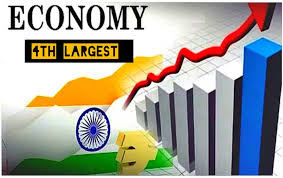
05-Jun-2025 12:00 PM
India Emerges as the World’s 4th Largest Economy
GS3 – Indian Economy | Development | IMF Report 2025
📌 Context
India is set to surpass Japan and become the 4th largest economy in the world by 2025, as per the IMF’s World Economic Outlook. With a projected nominal GDP of $4.187 trillion, India moves ahead of Japan ($4.186 trillion), only behind the US, China, and Germany. While this milestone reflects impressive macroeconomic progress, India’s per capita income remains low at $2,880, showing that the wealth is not evenly spread across the population.
📈 India’s Economic Rise: What’s Fueling It?
1. 🔥 Strong Consumption-Led Growth
India’s economy thrives on domestic demand, with private consumption contributing nearly 60% to the GDP. Rural spending has increased thanks to better connectivity and welfare schemes, while urban consumption is being driven by a young middle class eager to spend on education, gadgets, and travel.
2. 👶 Demographic Advantage
India has a median age of 29 years, making it one of the youngest nations globally. This “demographic dividend” ensures a productive workforce and economic growth for decades, provided jobs and skills match market demands.
3. 🛣️ Infrastructure & Digital Growth
India is investing heavily in roads, railways, energy, and ports. The Digital Public Infrastructure (like UPI, Aadhaar, and CoWIN) has made India a global model of financial and tech inclusion, connecting millions to services and platforms.
4. 🌍 Global Realignment Benefits
As global companies adopt the "China Plus One" strategy, India has emerged as a top alternative. Companies like Apple and Samsung are shifting manufacturing bases here. Strategic partnerships like India-Japan cooperation and QUAD alliances enhance India’s attractiveness.
5. 🧾 Reforms Driving Efficiency
Reforms like GST (one nation, one tax), Insolvency and Bankruptcy Code, and corporate tax cuts have made doing business in India simpler and more profitable, thus boosting investor confidence.
🚧 Challenges on the Path Ahead
1. 🌐 Global Headwinds
Geopolitical tensions like the Russia-Ukraine war and Red Sea crisis have increased shipping costs and supply chain disruptions. India’s exports are vulnerable to global shocks.
2. 💸 Inflation and Price Volatility
While overall inflation has eased to 4.8%, services inflation (education, health) remains high. Unpredictable fuel and food prices hurt household budgets and affect policy stability.
3. 🧑🏭 Job Market Disruptions
Despite growth, over 80% of India’s workforce is still informal. Automation and AI threaten low-skilled jobs, especially in manufacturing and IT. According to NASSCOM, 400 million workers need upskilling by 2030.
4. 📉 Export Weakness and Trade Deficits
While services exports and remittances help, goods exports have declined due to weak demand from Europe and China. The current account deficit narrowed to 1% of GDP, but trade remains a concern.
5. 🏙️ Infrastructure Needs
India’s Capex-to-GDP ratio is at a decade-high 3.3%, but more investment is needed, especially in green energy and urban infrastructure like Smart Cities and PM Gati Shakti.
🚀 Way Forward
Diversify Trade: Forge more FTAs with Africa, ASEAN, and Latin America to reduce overdependence on China and the West.
Boost Manufacturing: Focus on semiconductors, EVs, green hydrogen, and drones while supporting MSMEs.
Advance Digital Inclusion: Take UPI, ONDC, and 5G to rural areas and strengthen data governance.
Sustainable Growth: Tackle inequality, promote R&D, invest in education, startups, and climate-smart agriculture.
📘 MCQs
Q1. According to the IMF, which country is India expected to surpass to become the 4th largest economy in 2025?
A. Germany
B. UK
✅ C. Japan
D. France
Q2. What is India’s projected nominal GDP in 2025?
A. $5.58 trillion
✅ B. $4.187 trillion
C. $3.9 trillion
D. $2.88 trillion
Q3. Which of the following contributes the most to India’s GDP?
A. Government Spending
✅ B. Private Consumption
C. Exports
D. Investments
Q4. What is a major concern regarding India’s workforce?
A. High per capita income
B. Strong formal employment
✅ C. Informal employment dominance
D. Overskilled labor force
Q5. What is India’s current median age?
A. 33
✅ B. 29
C. 35
D. 26